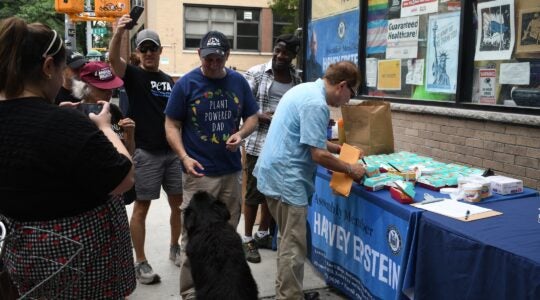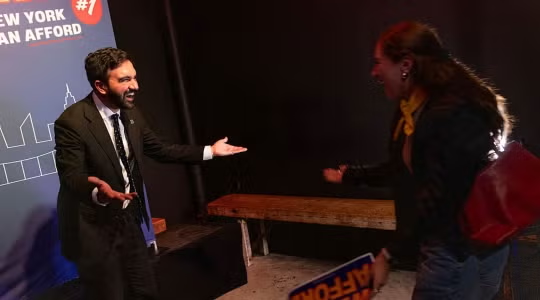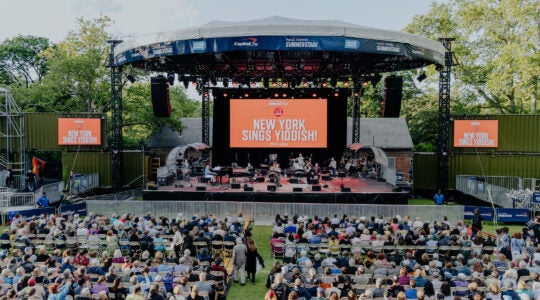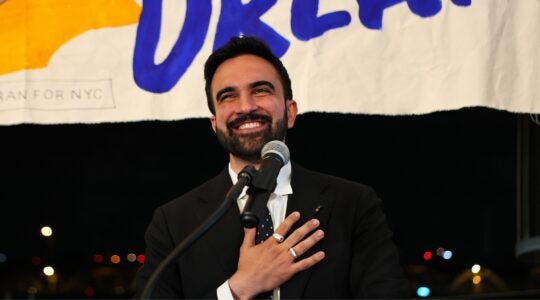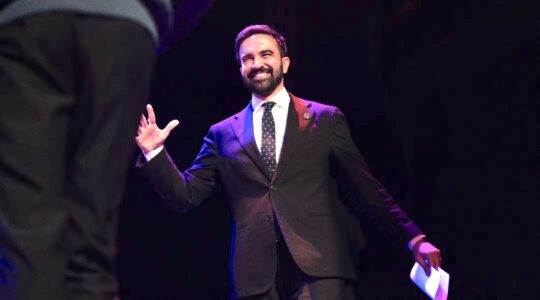Within the shiva week, astonishment at the murder of the Fogel family in Itamar gave way to the loneliness of long-distance mourning.
In New York, a handful of people started gathering at 9 a.m. outside Kehilath Jeshurun on East 85th Street, three hours before the doors would open for a memorial service for Udi, Ruth, Yoav, Elad and Hadas Fogel. Their faces — even their kitchen, where Ruth is forever at the sink, smiling and turning to us — were now as familiar as our own.
This is what Jews have always done: hearing mournful Jewish news from the other side of the world, we react as if it were family. During the Dreyfus trial in Paris, Sholom Aleichem wrote of how in his mythical Russian shtetl of Kasrilevke, “the entire little village instantly took Dreyfus to heart. He became one of theirs, a Kasrilevker.”
In 1913, during a Ukrainian blood libel, Jews packed the Grand Opera House in Chicago. In 1933, Bronx Jews packed the Kingsbridge Armory in solidarity with German Jews. In 1944, Jews on the Lower East Side packed the old Warsaw shul in a long-distance shiva for the Jews of Poland.
That is what Jews do. When it rains in Paris, said Sholom Aleichem, we open umbrellas in Odessa.
It was St. Patrick’s Day, and hours before the big shul opened, over on Lexington Avenue, just down the block, men in kilts were practicing “Minstrel Boy,” and “Danny Boy” on bagpipes:
“If I am dead, as dead I well may be,
Ye’ll come and find the place where I am lying
… All my grave will warmer, sweeter be,
For you will bend and tell me that you love me…”
For the Irish and the Jews, only the thinnest veil separates this world from the other.
The entire Ramaz High School was coming to the memorial at Kehilath Jeshurun, its mother shul. The day’s lesson was simple: This is what Jews do when Jews, even distant, are in trouble.
Rabbi Yossi Weiser, a teacher at Ramaz, said he’s been speaking about the Fogels with his class. What class was that, we asked. “What class?” he asked back, incredulous but smiling. “Yiddishkeit! We’re learning Yiddishkeit. We’re learning Gemara, but if this was the 1930s, would we not talk about what was happening?”
Like Mordechai explaining to Esther, Rabbi Weiser explained the challenge to his class, most of whom are children of privilege: “Do not think that you will be able to escape in the king’s palace.”
In the pews were people such as Glenn Richter, a Jewish activist since the early 1960s, and Alan Leicht, an Emmy Award-winning television writer. “The Fogels weren’t the target,” said Leicht. “It was simply a Jew-killing, any Jew who was convenient. It could have been any one of us.”
There was a buzz in the pews. Did you hear, one said to another, the Zaka post-terror volunteers, the ones who gather the blood and the body parts, arrived at the Fogel home and stayed as shomrim, honor guards for the five bloodied souls, until after Shabbat.
Two in the pews were discussing why there were no death photos of Ruth Fogel. There was a news report that Ruth picked up a rifle and followed her children’s screams, before being overcome in a way that was too painful to be photographed, even when the survivors allowed so much else to be photographed.
Said one woman, “Can you imagine? It was Shabbos.” Who can’t imagine their final hours? Ruth blessed the Shabbat candles, covering her eyes. Udi returned from shul, walking through the front door that still had the sign welcoming the new baby. Angels watch our homes on Friday nights, goes the legend, and the Angel of Death may have been there as well, if only to be a witness. The Fogels sang “Shalom Aleichem,” welcoming these angels, and “tzays-chem l’shalom,” may your departures be peaceful. Udi blessed each child, one by one. Surely, he kissed each child and if he didn’t kiss Ruth they must have caught each other’s eye.
Udi said Kiddush. As the Shabbat evening turned languid, and the children got into pajamas, the dinner plates, with chicken bones and carrots, were left unwashed in the sink. The dishes were still there a week later, when journalists and politicians were allowed to view the house.
Did you see, said one mourner in the shul to another, how Yoav, the 11-year-old, decorated his room? He had a little wooden plaque above his bed, containing a Hebrew prayer asking that it be God’s will that he fulfill the mitzvah of loving his neighbor as himself, “that I be loving and pleasant, gracious and merciful in the eyes of all who see me.”
Everyone in the shul — and there were more than 1,100 people — had a piece of the story. Did you hear? Elad, the 4-year-old, was going to dress up on Purim as Moshe Dayan.
Malcolm Hoenlein, executive vice chairman of the Conference of Presidents of Major American Jewish Organizations, was the one who initiated the Kehilath Jeshurun memorial, quickly co-sponsored by more than 40 Jewish institutions. “I wanted to give people a chance to come together,” said Hoenlein. “We need to comfort one another, to strengthen one another, to mourn together.” The first call he made was to Rabbi Haskel Lookstein, spiritual leader of Kehilath Jeshurun and principal of Ramaz, “I said we have to do something. He instantly said yes.”
Hoenlein didn’t do this because he had a Jewish job but because he had a Jewish heart, and a broken one. “I did this for me, I needed it. I see those kids faces in front of me,” said Hoenlein to a few people as the crowd was filing in.
“You can’t let a family be massacred and remain silent,” said Hoenlein. “I’ve always warned against, and been wary, about comparisons to the 1930s. I have to tell you, this makes me rethink it. And this has nothing to do with the Fogels living on a settlement. We’ve seen terrorists kill Jews in Jerusalem, Tel Aviv, Sderot and Haifa.”
In the formal portion of the memorial, Rabbi Lookstein said the Torah reading about Amalek just prior to Purim was “most appropriate,” Amalek being the enemy notorious for attacking the most vulnerable, a baby being a perfect example. The Fogels were “murdered by a modern-day Amalek,” said Rabbi Lookstein. “Savages. Beasts. Monsters.”
“When one Jew mourns,” said Eric Goldstein, of UJA-Federation of New York’s executive committee, “we are all in mourning. The pain of those in Itamar is our pain. The stab in their hearts is a stab in ours.”
Rabbi Yaakov Kermaier of the Fifth Avenue Synagogue and president of the New York Board of Rabbis, asked “mechilah,” or forgiveness, as family members often do at a funeral: When “the media” and others “vilified, demonized, and dehumanized people like the Fogels, who were treated as criminals for settling and building beautiful lives in the heartland of our ancestral home, did we protest loud enough?”
The memorial ended with the El Maale funeral hymn, and then “Hatikvah” and the “Star Spangled Banner,” which itself sounded like a prayer.
If only for ourselves, we were proof through the night that our flags were still there.
E-mail: jonathan@jewishweek.org
The New York Jewish Week brings you the stories behind the headlines, keeping you connected to Jewish life in New York. Help sustain the reporting you trust by donating today.
